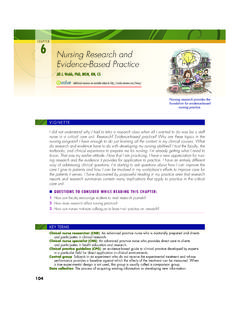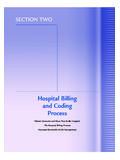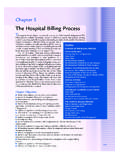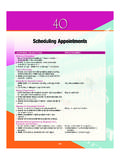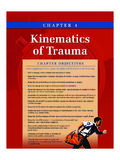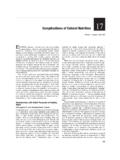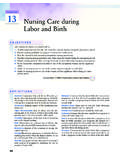Transcription of Nutritional Assessment and Planning in Clinical Care
1 For much of the past century, the role of nutrition in health care was eclipsedby achievements that transformed medical intervention. Greater knowledgeof micronutrient requirements and advances in public health eradicatedmost nutrient deficiencies. At the same time, pharmacologic and surgical cures relegated Nutritional care to a minor position among treatmentoptions (Feldman, 2000). As a result of these and other technologic break-throughs, Nutritional Assessment assumed a low priority in patient , however, a better understanding of the complex interplay betweennutrition and health has restored Nutritional Assessment to a position of keyimportance in patient , a designation used frequently in discussions of nutritionalassessment, is a broad and at times misleading term. In general, malnutri-tionrefers to a condition caused by a deficiency of nutrient intake orimpaired nutrient absorption.
2 Some definitions of malnutrition includestates of overnutrition in addition to conditions marked by nutritionaldeficits (American Society for Parenteral and Enteral Nutrition [ASPEN],1995). In hospitals, clinicians describing patients as malnourishedoften include individuals whose present Nutritional intake is less than opti-mal, even when no obvious Nutritional disturbances are present (Allison,2000). By recognizing potential, as well as actual, Nutritional deficits, thismore inclusive definition serves a practical purpose when applied to theacutely 6-1 lists diagnostic categories for common Nutritional kwashiorkorare terms that were once commonly used in clini-cal practice, but these labels generally apply more accurately to conditionsassociated with famine than with illness. Obesity, on the other hand, hasbecome the most common Nutritional problem seen in this country.
3 The poorclinical outcomes associated with excessive body weight justify the inclusionof obesity as a significant Nutritional Assessment and Planning in Clinical CareCHAPTER 6 Patricia Worthington, RN, MSN, 8/19/03 10:22 AM Page 159 Nutritional Assessment IN Clinical CAREN utritional Assessment for Acutely Ill PatientsThe 1970s saw a resurgence of interest in the role of nutrition in health carethat first focused on hospitalized patients. A series of studies published atthat time provided solid evidence of a problem clinicians had long sus-pected: Nutritional problems and illness frequently appear in conducted in hospitals of various patient populations placed theincidence of malnutrition between 30% and 55%, with estimates for elderlyhospitalized and institutionalized patients being even higher (Sullivan, Sun,and Walls, 1999; Vellas et al, 2001). This renewed interest in nutrition coin-cided with important advances in the ability to provide parenteral andenteral nutrition.
4 With the advent of effective methods for Nutritional sup-port came the need to identify malnourished patients and recognize riskfactors for developing malnutrition during and mortality increase when malnutrition accompanies acuteillness. A series of metabolic alterations and physiologic changes takes place,unfavorably affecting the course of illness and recovery. Box 6-2 lists the neg-ative effects of malnutrition during acute illness in more detail. Appropriatenutritional intervention plays a role in offsetting the complications associ-ated with malnutrition and improving Clinical Assessment in Primary CareGrowing evidence of clear links between dietary factors and chronic diseasehas also renewed interest in Nutritional intervention as a therapeutic modal-ity in primary care. As discussed in Chapter 5, Nutritional factors figureprominently in many chronic medical conditions, including coronary heartdisease, cancer, diabetes, hypertension, and osteoporosis.
5 In addition, thecurrent epidemic of obesity among all age-groups represents a major healthcrisis facing this country. The substantial risks for chronic disease and160 UNIT II Nutrition and IllnessBOX 6 1 Diagnostic Categories for Nutritional DisordersMarasmus: A Nutritional disorder caused by a deficit of energy intake,characterized by a cachectic appearance, with extreme muscle wasting and loss of subcutaneous : A form of malnutrition resulting from an extreme deficiency ofdietary protein. Symptoms include hypoalbuminemia, edema, ascites, and fatty malnutrition: A severe condition featuring elements of bothmarasmus and kwashiorkor, caused by a combined deficit of both energy obesity: Excessive body weight that interferes with normal physiologicprocesses such as breathing. Morbid obesity is associated with an increasedincidence of 8/19/03 10:22 AM Page 160increased mortality associated with obesity demands the close attention ofprimary care OF Nutritional ASSESSMENTR egardless of the Clinical setting, the obvious objective of Nutritional assess-ment is to identify patients with poor Nutritional status.
6 Every nutritionalassessment begins by taking into consideration the age-specific nutri-tional requirements and developmental issues discussed in Unit I. Beyondthat, the intermediate goals and even the method of Assessment can vary,depending on the Clinical status of the patient and the setting in which theassessment takes Assessment in primary care, for example, centers on promot-ing optimal health and preventing nutrition-related disease. This processplaces emphasis on recognizing dietary and lifestyle factors that affecthealth. Another key function of Nutritional Assessment in primary care is todetermine the need for therapeutic dietary adjustments for patients withchronic disease. For hospitalized patients the focus shifts toward identifyingways in which acute illness influences Nutritional status and the impact ofnutritional status on Clinical outcomes. Information gathered through nutri-tional Assessment in hospitalized patients should distinguish between thecauses and consequences of malnutrition and help in selecting patients mostlikely to benefit from Nutritional support (Jeejeebhoy, 2000).
7 In all health care settings, Nutritional Assessment serves as a means fortracking individual trends in Nutritional status over time. This capabilitydepends not on any single indicator but on information gathered from avariety of sources. To be truly useful, Nutritional Assessment must also formthe framework for a therapeutic plan and provide a way to evaluate theresponse to therapy. Table 6-1 provides more detail regarding the goals ofnutritional Assessment in both primary care and acute care OF Nutritional ASSESSMENTI nitial efforts to bring Nutritional Assessment to Clinical settings relied heav-ily on Assessment techniques used to document the incidence of malnutritionCHAPTER 6 Nutritional Assessment and Planning in Clinical Care161 BOX 6 2 Negative Effects of Malnutrition on Clinical OutcomesIncreased infectious complicationsReduced immune competencePoor skin integrityDelayed wound healingIncreased surgical complicationsProlonged length of stay, higher health care 8/19/03 10:22 AM Page 161in groups, such as the population of a developing nation.
8 These tradi-tional Nutritional Assessment techniques often proved poorly applicable dur-ing illness, however. Some traditional indexes still commonly used asnutritional markers, such as serum albumin, actually better reflect severityof illness than Nutritional status (Allison, 2000). Relying too heavily onserum albumin levels can lead to patients being classified as malnourishedwhen in fact disease-related factors account for the abnormal approaches to Nutritional Assessment that combineobjective data with relevant Clinical information are optimal. By drawingon information from a number of sources, clinicians are able to iden-tify Nutritional problems accurately and recognize barriers to optimalnutritional intake. Data gathered in the Assessment process then serveas the groundwork for incorporating Nutritional care into the patient streatment II Nutrition and IllnessGoals of Nutritional AssessmentNutritional Assessment for Hospitalized Nutritional Assessment in Primary CarePatientsTABLE 6 1 Identify patients with poor Nutritional dietary habits that increase the risk for chronic impact of existing medical problems on Nutritional patient s level of physical trends in growth and body evidence of nutrition-related chronic need for a therapeutic need for specific nutrient potential drug-nutrient use of herbal dietary impact of ethnic, cultural.
9 And religious influences on dietary need for Nutritional a framework for a Nutritional plan of means for serial evaluations to track patients with poor Nutritional risk factors for developing malnutrition as a result of barriers to adequate absorption and metabolism of risk of morbidity related to alterations in Nutritional Clinical consequences of poor patients who will benefit from specialized Nutritional impact of illness on protein and energy illness-based changes in requirements for specific potential drug-nutrient need for discharge Planning and patient teaching related to Nutritional a framework for a Nutritional plan of means for serial evaluations to track 8/19/03 10:22 AM Page 162 Nutritional ScreeningIn most health care settings, Nutritional Assessment takes place in two steps:an initial Nutritional screening followed by a more formal Nutritional assess-ment when indicated. Routine history and physical examinations incorpo-rate many components for Nutritional screening, such as height, weight,blood pressure, blood glucose levels, and lipid profile.
10 In addition, primarycare also includes screening for cancer and osteoporosis, conditions in whichnutrition or body weight plays a prominent Joint Commission on Accreditation of Healthcare Organizations(JCAHO) also requires that Nutritional screening be performed for patientsin all types of health care settings. The objective of this mandated screeningis to detect actual or potential Nutritional deficits rather than determine therisk for nutrition-related disease. The screening process assigns a level ofnutritional risk to patients that is based on their answers to a series of sim-ple questions about general health, eating habits, weight loss, physicalsymptoms, functional status, and social care facilities may use a published screening tool that has beenvalidated through research (see Chapter 4, Figure 4-1, for one example) ordevelop a screening questionnaire that is more specific to the populationserved by the facility.

